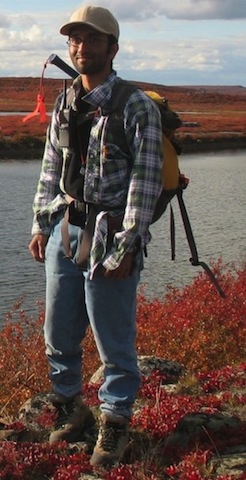Biography:
A road trip along the Columbia Icefields Parkway in 2005 sparked my interest in geology with the question: “What are these mountains and how did they get here?” This started my career in geology, which has involved a BSc, a short experience with industry, an MSc and an on-going PhD. Over the course of my experience, my original question has evolved into a much more general “What is the nature of the solid Earth and how has it come to be so?” After an MSc studying the source of Paleoproterozoic mafic dykes in the Northwest Territories, Nunavut and Saskatchewan, my current interest lies in understanding the growth of continents at active margins.
My preferred mode of answering these geological questions has been through the tools of geochemistry (elemental and isotopic; mineral and whole-rock) although I undertake (and greatly enjoy) occasional forays into the realms of structural geology, mapping and some statistical analyses. Over the course of my PhD I intend on adding experimental petrology to my geological toolbox, in addition to adding grey hairs to my head. Aside from fulfilling my intellectual curiosities, my work in geology has complemented my other interests in hiking, photography, map making and singing ‘The Gambler’ in remote and beautiful places. As my career progresses I look forward to continuing to expand (and attempt to answer) my guiding question through research, teaching, public outreach and public education.
Project: Trace Element Geochemistry of Hornblende from the Bonanza Arc, Vancouver Island, Canada
This project is the second part of my PhD dissertation, in which I study crustal differentiation and the evolution of island arcs and related Cu enrichments in space and time.
Porphyry Cu deposits (PCDs) are the world’s primary source of Cu and Mo, and an important source of other elements like Au, Ag etc. PCDs are formed in association with subduction-related magmas and are found in magmatic arcs of all ages worldwide, although they are best preserved in Tertiary arcs. British Columbia is known to host several PCDs that are economically feasible to mine.
It has been long been recognized that there is an intimate link between tectonic and magmatic cycles in arcs and porphyry formation. However the source of the Cu enrichment is unclear as the sub-arc mantle shows no comparably elevated Cu concentrations. My project will test recent hyptheses that Cu enrichment in arcs is a two step process involving, a) the ‘pre-concentration’ of Cu and other chalcophile elements in the lower crust of arcs, and b) the subsequent melting of these lower crustal rocks to liberate the Cu into magmas that go on to form PCDs. I will test various aspects of this hypothesis using natural ultramafic samples from the Bonanza arc on Vancouver Island. This Jurassic island arc is well exposed and also hosted the Island Copper mine in years past, making it an ideal candidate for this study.
